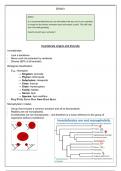Summary
Summary ZEN251 Exam Notes
- Course
- ZEN251 (ZEN251)
- Institution
- University Of Pretoria (UP)
Origin and extent of modern invertebrate diversity; parasites of man and domestic animals; biology and medical importance of arachnids and insects; insect life styles; the influence of the environment on insect life histories; insect herbivory; predation and parasitism; insect chemical, visual, and...
[Show more]



